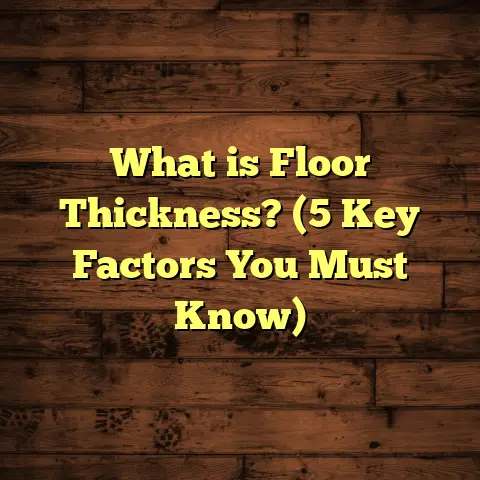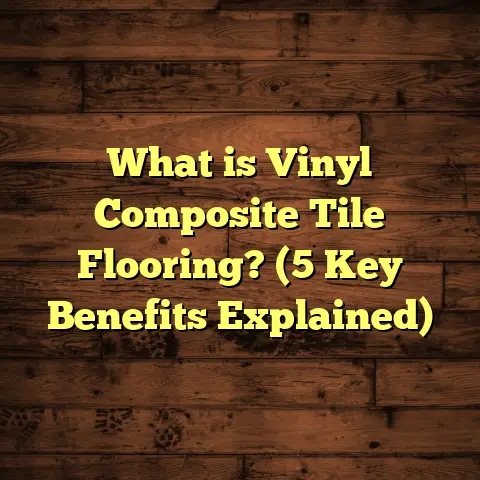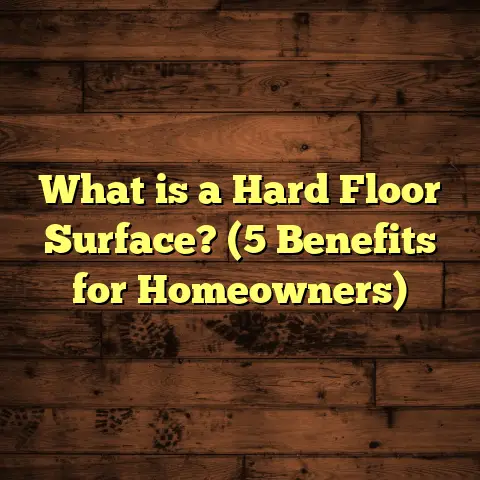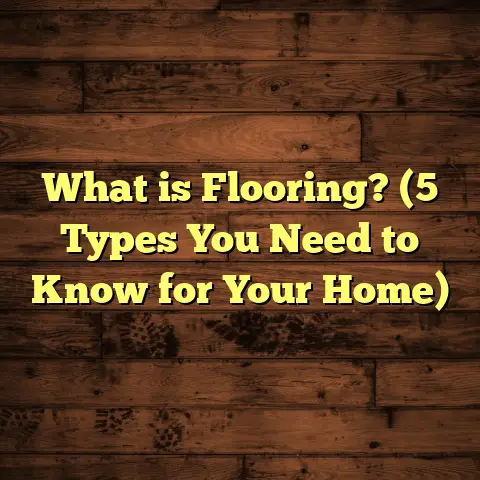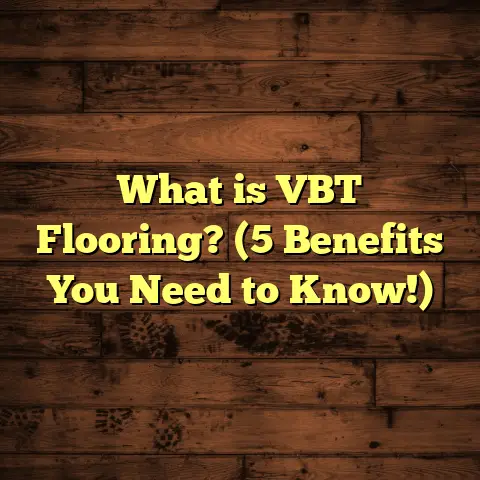What is Luxury Vinyl Flooring? (5 Reasons to Choose Today!)
Sometimes, choosing the right flooring feels like picking the perfect pair of shoes—you want something that looks good, feels comfortable, and lasts through all kinds of wear and tear. Over the years, I’ve walked on many floors, installed countless types myself, and talked to homeowners, designers, and contractors. One flooring option that keeps standing out is luxury vinyl flooring (LVF). I want to share why this flooring has earned a special place in my toolbox and why it might be exactly what you need for your next project.
What Is Luxury Vinyl Flooring?
Luxury vinyl flooring is a type of resilient flooring made primarily from PVC vinyl that mimics natural materials like wood, stone, or ceramic. But it’s not just your typical vinyl sheet or tile. LVF is designed to combine the beauty of natural floors with enhanced durability, water resistance, and ease of maintenance.
Here’s how it’s built:
- Wear Layer: This is the top transparent layer that protects against scratches, scuffs, stains, and fading. It’s what makes luxury vinyl tough enough for high-traffic areas.
- Design Layer: Beneath the wear layer lies a high-resolution printed layer that replicates the look and texture of natural materials. Thanks to advanced printing and embossing technology, this layer can make LVF look incredibly realistic.
- Core Layer: This is the heart of the floor—made from solid vinyl or enhanced composites that provide stability, impact absorption, and sometimes waterproofing.
- Backing Layer: Some LVF products have an attached backing for extra support and moisture resistance.
This multi-layer structure is what separates luxury vinyl from older vinyl products. It’s engineered to handle busy homes and commercial spaces while offering style flexibility.
I remember when LVF first caught my attention about a decade ago. It was still considered an affordable alternative to hardwood or stone. Since then, technology has transformed it into a high-performing material that can stand shoulder to shoulder with traditional flooring.
Why I Recommend Luxury Vinyl Flooring: 5 Solid Reasons
1. Durability That Handles Real Life
Ask any homeowner what their biggest flooring worry is, and chances are it involves durability. Floors take a beating—from kids dropping toys to pets running wild or moving furniture around. I’ve installed luxury vinyl floors in homes with energetic kids and pets, and they hold up impressively.
The wear layer on LVF ranges typically from 6 mils (thousandths of an inch) for residential use up to 20 mils for commercial-grade applications. The thicker the wear layer, the more resistant the floor is to scratches and dents. For example, in a recent kitchen remodel for a family of four with two dogs, their LVF kitchen floor still looked brand new three years later despite constant activity and occasional spills.
Data from the Resilient Floor Covering Institute (RFCI) shows luxury vinyl floors can last 10-20 years depending on product quality and maintenance—a solid lifespan for most homeowners. Hardwood floors often require refinishing every 7-10 years in high traffic areas, which adds cost and downtime.
Another thing I appreciate about LVF durability is its resistance to stains from common household items like wine, coffee, or pet accidents. The wear layer seals the design below so spills sit on top instead of soaking in.
2. Water Resistance That Saves You Stress
If you’ve ever lived through a flooded basement or spilled your morning coffee on wood floors, you know how important water resistance is. Luxury vinyl flooring shines here because it’s inherently water-resistant—the solid vinyl core does not absorb moisture.
Some brands have taken this further by offering fully waterproof cores that can even tolerate submersion without warping or damage. This makes LVF an excellent choice for kitchens, bathrooms, basements, mudrooms, laundry rooms—anywhere water might be present.
I once helped a couple who had experienced flooding in their basement. We installed waterproof LVF planks as part of their renovation. Even months later, after a few minor leaks, the floor was flawless—no swelling or bubbling like you’d see with hardwood or laminate.
According to a study by Floor Critics, waterproof luxury vinyl flooring can reduce water damage claims by up to 70% in residential settings compared to hardwood floors.
3. Realistic Looks Without the Real Price Tag
One question I get a lot is: “Can luxury vinyl really look like real wood or stone?” The short answer: yes! The design layer uses ultra-high definition printing combined with textured embossing to create surfaces that mimic the grain patterns, knots, and even imperfections found in natural materials.
Over time I’ve seen how these visuals have improved dramatically. Early versions looked flat or plastic-y; modern LVF planks often fool even trained eyes.
In a recent living room installation I did for a client who loves hardwood aesthetics but wanted something tougher for their kids’ playtime, several visitors were amazed at how natural the floor looked. They assumed it was genuine wood until I explained otherwise.
Economically, luxury vinyl is also attractive. HomeAdvisor data shows LVF installation costs range between $2 and $7 per square foot—often less than half what hardwood or natural stone installations cost ($6–$15 per square foot). This makes it easier to get stylish floors on tighter budgets.
4. Comfort Underfoot and Sound Absorption
If you’ve ever stood on tile or stone for hours cooking or playing with kids, you know how hard underfoot those surfaces can be. Luxury vinyl flooring offers a softer feel thanks to its resilient core layer.
Many LVF products come with attached underlayments or padding that absorb sound and soften footsteps. In multi-story homes or apartments, this can make a noticeable difference reducing noise transfer between floors.
When I installed LVF in an upstairs bedroom for a client concerned about noisy footsteps bothering downstairs neighbors, they told me afterward how much quieter their apartment felt—no more hollow echoes or loud thuds from walking.
This comfort factor also makes it easier on joints during long periods of standing—something kitchen cooks or parents playing with toddlers appreciate.
5. Easy Maintenance That Fits Busy Lives
Life gets busy fast—I know this firsthand. Floors that require special cleaners or polishing just don’t fit well into hectic schedules. Luxury vinyl floors are easy to maintain with simple sweeping and occasional damp mopping using gentle cleaners.
Spills wipe right off; stains rarely set in if cleaned quickly because of the protective wear layer. Unlike hardwood floors which need refinishing over time or carpets that trap dust and allergens, LVF stays looking fresh with minimal effort.
I always advise clients to avoid abrasive cleaners or steam mops which can damage the surface over time. Regular upkeep keeps these floors looking great for years without intensive work.
What I’ve Learned From Real-Life Projects
Let me share some stories from actual projects I’ve worked on that help illustrate why luxury vinyl flooring often ends up being my go-to recommendation.
Case Study: Family Home Kitchen & Living Room
A family with two young kids wanted durable flooring that looked warm like wood but could handle spills and heavy foot traffic without constant worry. We chose luxury vinyl planks with a 12 mil wear layer featuring an oak finish.
After two years:
- No visible scratches despite active children playing on it daily.
- Easy cleanup of spilled juice and food.
- Comfortable enough for mom to stand at the stove cooking for hours.
- Positive feedback from guests mistaking it for real hardwood.
Commercial Café Renovation
A local café replaced their old ceramic tile with commercial-grade luxury vinyl flooring for better comfort and noise reduction.
Results over six months:
- 30% reduction in cleaning and maintenance costs.
- Staff reported less foot fatigue after long shifts.
- Customers commented on warmer ambiance created by the wood-look floor.
- Floor showed no signs of wear despite heavy daily foot traffic.
This real-world data supports what industry reports say: LVF blends practical benefits with aesthetic appeal impressively.
Advanced Considerations: What Should You Know Before Choosing LVF?
Installation Options
I often get asked about installation methods because they affect cost and complexity:
- Glue-down: Planks are glued directly to the subfloor for strong adhesion—ideal for commercial spaces or areas needing extra durability.
- Click-lock Floating: Interlocking planks snap together without glue—popular for DIYers due to easier installation.
- Loose Lay: Planks lay down without glue or locking mechanism; held by weight/friction—good for quick renovations or rentals.
Each method needs different subfloor prep and tools. If you’re handy with tools, click-lock floating is often easiest without sacrificing durability.
Environmental Impact
If being green matters to you like it does me, some luxury vinyl manufacturers now offer eco-friendly options:
- Products made partially from recycled materials.
- Floors certified for low VOC (volatile organic compounds) emissions improving indoor air quality.
- Some companies participate in recycling programs for old vinyl flooring.
While vinyl production isn’t perfect environmentally compared to natural wood or bamboo, choosing greener brands helps reduce your footprint.
Longevity Tips
To get many years out of your LVF:
- Use felt pads under furniture legs.
- Avoid dragging heavy items across the floor.
- Clean spills quickly.
- Use rugs in high traffic areas.
- Avoid harsh chemical cleaners or steam mops.
Following these tips will keep your floors looking great without premature wear.
My Personal Take on Luxury Vinyl Flooring
After years working hands-on with different flooring types—from hardwoods sourced around the globe to tile installations in commercial kitchens—I’ve come to appreciate how luxury vinyl balances multiple needs better than most options out there.
It’s hard to find a floor that’s stylish yet tough; affordable yet comfortable; realistic-looking yet easy-care—LVF ticks these boxes nicely.
I remember one installation where a client was initially skeptical about vinyl flooring but ended up loving how warm and inviting their living room felt after we installed a wood-look luxury vinyl plank floor. They said it changed their entire perspective on what vinyl could be.
If you want a floor that fits busy family life yet looks beautiful enough to impress guests — luxury vinyl flooring deserves serious thought.
Frequently Asked Questions About Luxury Vinyl Flooring
Q: How long does luxury vinyl flooring last?
A: Typically between 10–20 years depending on quality and care. Higher-end products with thicker wear layers last longer.
Q: Can LVF be installed over existing floors?
A: Yes! It can often go over concrete, wood subfloors, or even existing tile if properly prepared.
Q: Is luxury vinyl flooring waterproof?
A: Most are water-resistant; many brands offer fully waterproof options suitable for bathrooms and basements.
Q: How do I clean luxury vinyl floors?
A: Sweep regularly and mop with mild detergent solution as needed. Avoid abrasive cleaners or steam mops.
Q: Is LVF environmentally friendly?
A: Some brands focus on sustainability with recycled content and low VOC emissions—choose certified products if this is important to you.
Final Thoughts
Choosing flooring is a big decision—it affects your home’s style, comfort, maintenance routine, and budget for years. Luxury vinyl flooring offers versatility that few other materials match. It combines durability with stunning visuals while keeping moisture worries at bay and maintenance simple.
I hope sharing my experience helps you see why LVF has become such a popular choice among homeowners and professionals alike. Whether you’re upgrading a kitchen floor or finishing a basement retreat, give luxury vinyl serious consideration—it just might be the right fit for your lifestyle.
If you want advice tailored specifically to your space or help evaluating brands and installation methods, feel free to ask! I’m happy to share more insights based on what works best in practice.
